Forest Structure, Wood Standing Stock, and Tree Biomass in Different Restoration Systems in the Brazilian Atlantic Forest
Abstract
:1. Introduction
2. Materials and Methods
2.1. Study Area
2.2. Description of the Restoration Systems, Site Preparation, and Maintenance
- Direct seeding (DIRS), sowing of five fast-growing heliophyllous tree species (Supplementary Appendices Table S1, Group A), at a spacing of 1.0 × 1.0 m spacing and a depth of 5 cm, with two to four seeds per spot. This system was implemented 1 year prior to the others.
- Agroforestry system (AFS), modified “Taungya” system. Mixed plantation with seedlings of 10 fast-growing tree species (1332 ind·ha−1) and 10 slow- to medium-growing tree species (660 ind·ha−1), each group allocated in the same planting line. Trees were arranged in triple lines (fast-slow-fast growth), interspaced with 5-m-wide alleys, where annual crops (beans, maize, cassava, pumpkin, sweet potato) were cultivated during the first 3 years. After 9 to 10 years, 14 fruit tree species were introduced at the Ultisol site and three medicinal tree species at the Alfisol site (Supplementary Appendices Table S2). After 14 years, one exotic tree species (Mimosa caesalpiniifolia Benth, Fabaceae) was removed from half of each experimental plot [34] using a split-plot design. Thus, the AFS treatment was subdivided into AFSm (managed) and AFS (control).
- Commercial mixed plantation (MIX). Consortium of 15 commercial timber, slow-growing species (Groups C–D) and 10 firewood (Groups A–B) (Supplementary Appendices Table SA), fast-growing species, each group allocated in the same planting line at a density of 2500 individuals per hectare. After 14 years, one exotic tree species (Mimosa caesalpiniifolia Benth, Fabaceae) was removed from half of each experimental plot [34], using a split-plot design. Thus, the MIX treatment was subdivided into MIXm (managed) and MIX (control).
- High-diversity tree plantation (HDIV). Mixed plantation of 40 tree species (Supplementary Appendices Table S1) per plot of different ecological groups; planting density was 2500 individuals per hectare.
2.3. Experimental Design and Data Collection
2.4. Data Analysis
3. Results
4. Discussion
5. Conclusions
Supplementary Materials
Author Contributions
Funding
Acknowledgments
Conflicts of Interest
References
- Paquette, A.; Messier, C. The role of plantations in managing the world’s forests in the Anthropocene. Front. Ecol. Environ. 2009, 8, 27–34. [Google Scholar] [CrossRef]
- BRASIL. Lei Federal nº 12.651, de 25 de Maio 2012. Dispõe Sobre a Proteção da Vegetação Nativa. Available online: http://www.planalto.gov.br/ccivil_03/_Ato2011-2014/2012/Lei/L12651.htm (accessed on 21 August 2016).
- Planaveg. Plano Nacional de Recuperação da Vegetação Nativa; Ministério do Meio Ambiente, Ministério da Agricultura, Pecuária e Abastecimento, Ministério da Educação: Brasília, Brazil, 2017; p. 73. Available online: http://www.mma.gov.br/images/arquivos/florestas/Planaveg_ingl%C3%AAs.pdf (accessed on 28 May 2019).
- Brasil. Decreto nº 8972, de 23 de Janeiro de 2017. Institui a Política Nacional de Recuperação da Vegetação Nativa. Available online: http://www.planalto.gov.br/ccivil_03/_ato2015-2018/2017/decreto/D8972.htm (accessed on 13 July 2018).
- United Nations Climate Change. Paris Agreement Targets. Adopted on 12 December 2015. Available online: https://unfccc.int/process-and-meetings/the-paris-agreement/the-paris-agreement (accessed on 15 May 2018).
- IBA, Indústria Brasileira de Árvores. Relatório 2017; IBA: Brasília, Brazil, 2017; p. 80. Available online: https://iba.org/images/shared/Biblioteca/IBA_RelatorioAnual2017.pdf (accessed on 5 April 2017).
- CAR, Cadastro Ambiental Rural. Consulta Pública. Available online: http://www.car.gov.br/publico/imoveis/index (accessed on 23 April 2018).
- Engel, V.L. Princípios silviculturais aplicados à restauração ecológica. Ação Ambiental 2011, 45, 7–9. [Google Scholar]
- Engel, V.L. Manejo sustentável e restauração florestal. In Seminário Temático Sobre Recuperação de Áreas Degradadas: A Resolução SMA 21 de 21/11/2001 como Recurso Gerencial para a Recuperação de Áreas Degradadas: Avanços Obtidos e Perspectivas Futuras; Instituto de Botânica: São Paulo, Brasil, 2003; pp. 21–31. [Google Scholar]
- Brancalion, P.H.S.; Viani, R.A.G.; Strassburg, B.B.N.; Rodrigues, R.R. Finding the money for tropical forest restoration. Unasylva 2012, 63, 25–34. [Google Scholar]
- Mansourian, S.; Stanturf, J.; Derkyi, M.A.A.; Engel, V.L. Forest landscape restoration: Increasing the positive impacts of forest restoration or simply the area under tree cover? Restor. Ecol. 2017, 25, 178–183. [Google Scholar] [CrossRef]
- Engel, V.L. Restoring tropical forests. Rev. Opin. 2016, 13, 34–35. [Google Scholar]
- FRA. Terms and Definitions; Forest Resources and Assessment Working Paper 180 FAO Forestry Department: Rome, Italy, 2015; p. 36. Available online: http://www.fao.org/3/a-ap862e.pdf (accessed on 25 April 2017).
- Vieira, S.A.; Alves, L.F.; Aidar, M.; Araújo, L.S.; Baker, T.; Batista, J.L.F.; Campos, M.C.; Camargo, P.B.; Chave, J.; Delitti, W.B.C.; et al. Estimation of biomass and carbon stocks: The case of the Atlantic Forest. Biota Neotrop. 2008, 8, 21–29. [Google Scholar] [CrossRef]
- Clark, D.A.; Brown, S.; Kicklighter, D.W.; Chambers, J.Q.; Thomlinson, J.R.; Ni, J.; Holland, E.A. Net primary production in tropical forests: An evaluation and synthesis of existing field data. Ecol. Appl. 2001, 11, 371–384. [Google Scholar] [CrossRef]
- Malhi, Y.; Doughty, C.; Galbraith, D. The allocation of ecosystem net primary productivity in tropical forests. Philos. Trans. R Soc. Lond B Biol. Sci. 2011, 366, 3225–3245. [Google Scholar] [CrossRef] [Green Version]
- Sullivan, M.J.P.; Talbot, J.; Lewis, S.L.; Phillips, O.L.; Qie, L.; Begne, S.K.; Chave, J.; Cuni-Sanchez, A.; Hubau, W.; Lopez-Gonzalez; et al. Diversity and carbon storage across the tropical forest biome. Sci. Rep. Nat. 2017, 7, 39102. Available online: https://www.nature.com/articles/srep39102 (accessed on 20 April 2017). [CrossRef] [Green Version]
- Sullivan, M.J.P.; Deere, N.J.; Guillera-Arroita, G.; Baking, E.L.; Bernard, H.; Pfeifer, M.; Reynolds, G.; Wearn, O.R.; Davies, Z.G.; Struebig, M.J. High Carbon Stock forests provide co- benefits for tropical biodiversity. J. Appl. Ecol. 2018, 55, 997–1008. [Google Scholar]
- Parrotta, J.A.; Wildburger, C.; Mansourian, S. Understanding Relationships between Biodiversity, Carbon, Forests and People: The Key to Achieving REDD+ Objectives. A Global Assessment Report Prepared by the Global Forest Expert Panel on Biodiversity, Forest Management, and REDD+; World Series; IUFRO: Vienna, Austria, 2012; Volume 31, p. 161. Available online: https://www.iufro.org/science/gfep/biodiv-forman-redd-panel/report/ (accessed on 30 June 2019).
- Brancalion, P.H.S.; Schweizer, D.; Gaudare, U.; Mangueira, J.R.; Lamonato, F.; Farah, F.T.; Nave, A.G.; Rodrigues, R.R. Balancing economic costs and ecological outcomes of passive and active restoration in agricultural landscapes: The case of Brazil. Biotropica 2016, 48, 856–867. [Google Scholar] [CrossRef]
- Lamb, D.; Erskine, P.; Parrotta, J. Restoration of degraded tropical forest landscapes. Science 2005, 310, 1628–1632. [Google Scholar] [CrossRef] [PubMed]
- Suganuma, M.; Durigan, G. Indicators of restoration success in riparian tropical forests using multiple reference ecosystems. Restor. Ecol. 2015, 23, 238–251. [Google Scholar] [CrossRef]
- Campoe, O.C.; Stape, J.L.; Mendes, J.C.T. Can intensive management accelerate the restoration of Brazil’s Atlantic forests? Forest Ecol. Manag. 2010, 59, 1808–1814. [Google Scholar] [CrossRef]
- Kanowski, J.; Catterall, C. Carbon stocks in above-ground biomass of monoculture plantations, mixed species plantations and environmental restoration plantings in north-east Australia. Ecol. Manag. Restor. 2010, 11, 119–126. [Google Scholar] [CrossRef]
- Ferez, A.P.C.; Campoe, O.C.; Mendes, J.C.T.; Stape, J.L. Silvicultural opportunities for increasing carbon stock in restoration of Atlantic forests in Brazil. Forest Ecol. Manag. 2015, 350, 40–45. [Google Scholar] [CrossRef]
- Souza, A.L.; Boina, A.; Soares, C.P.B.; Vital, B.R.; De Oliveira Gaspar, R.; De Lana, J.M. Estoque e crescimento em volume, biomassa, carbono e dióxido de carbono em Floresta Estacional Semidecidual. Revista Árvore 2011, 35, 1277–1285. [Google Scholar] [CrossRef]
- Ribeiro, S.C.; Jacovine, L.A.G.; Soares, C.P.B.; Martins, S.V.; Nardelli, A.M.B.; Souza, A.L. Quantificação de biomassa e estimativa de estoque de carbono em uma capoeira da zona da mata mineira. Revista Árvore 2010, 34, 495–504. [Google Scholar] [CrossRef]
- Alvares, C.A.; Stape, J.L.; Sentelhas, P.C.; De Moraes, G.; Leonardo, J.; Sparovek, G. Köppen’s climate classification map for Brazil. Meteorologische Zeitschrift 2013, 22, 711–728. [Google Scholar] [CrossRef]
- IBGE. Manual Técnico da Vegetação Brasileira; Instituto Brasileiro de Geografia e Estatística: Rio de Janeiro, Brazil, 2012; p. 271. Available online: https://biblioteca.ibge.gov.br/visualizacao/livros/liv63011.pdf (accessed on 4 April 2017).
- Nogueira Junior, L.R. Caracterização de Solos Degradados Pela Atividade Agrícola e Alterações Biológicas Após Reflorestamentos com Diferentes Associações de Espécies da Mata Atlântica. Master’s Thesis, São Paulo University, São Paulo, Brazil, 2000. [Google Scholar]
- Nogueira Junior, L.R.; De Moraes Gonçalves, J.L.; Engel, V.L.; Parrotta, J. Soil dynamics and carbon stocks 10 years after restoration of degraded land using Atlantic Forest tree species. Forest Syst. 2011, 20, 536–545. [Google Scholar] [CrossRef] [Green Version]
- Engel, V.L.; Parrotta, J. An evaluation of direct seeding for reforestation of degraded lands in central São Paulo state, Brazil. Forest Ecol. Manag. 2001, 152, 169–181. [Google Scholar] [CrossRef]
- Siddique, I.; Engel, V.L.; Parrotta, J.A.; Lamb, D.; Nardoto, G.B.; Ometto, J.P.; Martinelli, L.A.; Schmidt, S. Dominance of legume trees alters nutrient relations in mixed species forest restoration planting within seven years. Biogeochemistry 2008, 88, 89–101. [Google Scholar] [CrossRef]
- Podadera, D.S.; Engel, V.L.; Parrotta, J.A.; Machado, D.L.; Sato, L.M.; Durigan, G. Influence of removal of a non-native tree species Mimosa caesalpiniifolia Benth. on the regenerating plant communities in a tropical semideciduous forest under restoration in Brazil. Environ. Manag. 2015, 56, 1148–1158. [Google Scholar] [CrossRef] [PubMed]
- Forzza, R.C.; Costa, A.F.; Walter, B.M.T.; Bicudo, C.; Moura, C.W.N.; Peralta, D.F.; Costa, D.P.; Barros, F.; Lima, H.C.; Prado, J. Flora do Brasil 2020 em Construção. Jardim Botânico do Rio de Janeiro. 2013. Available online: http://floradobrasil.jbrj.gov.br/ (accessed on 20 April 2017).
- Ré, D.S. Equações Volumétricas e Produção de Madeira em Plantios Mistos Visando à Restauração da Floresta Estacional Semidecidual. Master’s Thesis, São Paulo State University, São Paulo, Brazil, 2011. [Google Scholar]
- Nogueira Junior, L.R.; Rodrigues, L.; Engel, V.L.; Parrotta, J.A.; Melo, A.C.G.D.; Ré, D.S. Allometric equations for estimation of tree biomass in mixed plantations with native species in the restoration of the Atlantic Forest. Biota Neotrop. 2014, 14, 1–9. [Google Scholar] [CrossRef]
- Hammer, O.; Harper, D.A.T.; Ryan, P.D. PAST: Paleontological statistics software package for education and data analysis. Palaeontol. Electron. 2001, 4, 9. [Google Scholar]
- Magurran, A.E. Measuring Biological Diversity Malden; Blackwell Publishing: Hoboken, NJ, USA, 2004; p. 256. [Google Scholar]
- R Development Core Team. R: A Language and Environment for Statistical Computing; Versão 3.1.4; R Foundation for Statistical Computing: Vienna, Austria, 2017. [Google Scholar]
- Stuble, K.; Fick, S.; Young, T. Every restoration is unique: Testing year effects and site effects as drivers of initial restoration trajectories. J. Appl. Ecol. 2017, 54, 1051–1057. [Google Scholar] [CrossRef]
- Figueiredo, L.P.I. A comunidade regenerante em diferentes sistemas de restauração ecológica na floresta estacional semidecidual. Master’s Thesis, São Paulo State University, São Paulo, Brazil, 2018. [Google Scholar]
- Villota Céron, D.E. Chuva de sementes do solo em diferentes sistemas de restauração ecológica da floresta estacional semidecidual. Master’s Thesis, São Paulo State University, São Paulo, Brazil, 2015. [Google Scholar]
- Geyer, W.; Lynch, K. Use of site index as a forestry management tool. Trans. Kans. Acad. Sci. 1987, 90, 45–51. [Google Scholar] [CrossRef]
- Batista, J.L.F.; Couto, H.T.Z. O estéreo. METRVM 2002, 2, 1–18. Available online: http://cmq.esalq.usp.br/Philodendros/lib/exe/fetch.php?media=metrvm:metrvm:metrvm-2002-n02.pdf (accessed on 10 July 2019).
- Barnes, B.V.; Zak, D.R.; Denton, S.R.; Spurr, S.H. Forest Ecology, 4th ed.; John Wiley and Sons Inc.: New York, NY, USA, 1998; p. 774. [Google Scholar]
- Taylor, P. Growing Up: Forestry in Queensland; Allen & Unwin: St. Leonards, NSW, Australia, 1994; p. 242. [Google Scholar]
- Oliveira, R.M. Desempenho ecofisiológico de mudas de Euterpe edulis Martius de diferentes estádios de desenvolvimento e implicações para a restauração ecológica. Master’s Thesis, São Paulo State University, São Paulo, Brazil, 2015. [Google Scholar]
- Fideles-Pontes, D.M. Effects of restoration systems on water retention capacity of accumulated litter and soil moisture at two sites with contrasting soil properties. In Book of Abstracts of the World Conference on Ecological Restoration, Foz do Iguassu, Brazil, 27 August–1 September 2017; Society for Ecological Restoration: Washington, DC, USA, 2017; p. 422. Available online: http://ser2017.org/ser2017_livroresumos-site.pdf (accessed on 3 July 2018).
- Von Guillhaussen, P.; Rascher, U.; Jablonowski, N.D.; Plückers, C.; Beierkuhnlein, C.; Temperton, V.M. Priority effects of time of arrival of plant functional groups override sowing interval or density effects: A grassland experiment. PLoS ONE 2014, 9, 1–11. [Google Scholar] [CrossRef]
- Bognola, I.A.; Dedecek, R.A.; Lavoranti, O.J.; Higa, A.R. Influência das propriedades físico-hídricas do solo no crescimento de Pinus taeda. Pesqui Florest Bras. 2010, 30, 37–49. [Google Scholar] [CrossRef]
- Nogueira Junior, L.R. Estoque de carbono na fitomassa e mudanças nos atributos do solo em diferentes modelos de restauração da Mata Atlântica. Ph.D. Thesis, São Paulo University, São Paulo, Brazil, 2010. [Google Scholar]
- Palma, H.A.L.; Moreno, J.S.; Ballarin, A.W. Compensados de Guapuruvu (Schizolobium parahyba (Vell.) S. F. Blake). In Proceedings of the Anais Congresso Brasileiro de Ciência e Tecnologia da Madeira, Madeira, Portugal, 4–6 September 2017; Available online: https://proceedings.science/cbctem/papers/compensados-de-guapuruvu-%28schizolobium-parahyba-%28vell.%29-s.-f.-blake%29 (accessed on 24 May 2019).
- Ferreira, J.; Lennox, G.D.; Gardner, T.A.; Thomson, J.R.; Berenguer, E.; Lees, A.C.; Mac Nally, R.; Aragão, L.E.; Ferraz, S.F.; Louzada, J.; et al. Carbon-focused conservation may fail to protect the most biodiverse tropical forests. Nat. Clim. Change 2018, 8, 744–749. [Google Scholar] [CrossRef]
- Lima, J.P.C.; Leão, J.R.A. Dinâmica de crescimento e distribuição diamétrica de fragmentos de florestas nativa e plantada na Amazônia Sul Ocidental. Floresta e Ambiente 2013, 20, 70–79. [Google Scholar] [CrossRef]
- Souza, A.L.; Jesus, R.M. Distribuição diamétrica de espécies arbóreas da Floresta Atlântica: Análise de agrupamento; Serviço do Instituto de Florestas (Boletim Técnico, 10): Viçosa, Brazil, 1994; p. 30. [Google Scholar]
- Ré, D.S.; Engel, V.L.; Ota, L.M.S.; Blanco Jorge, L.A. Equações alométricas em plantios mistos visando à restauração da Floresta Estacional Semidecidual. Cerne 2015, 21, 133–140. [Google Scholar] [CrossRef]
- Oliveira, R.E.; Carvalhaes, M. Agroforestry as a tool for restoration in Atlantic Forest: Can we find multi-purpose species? Oecologia Aust. 2016, 20, 425–435. [Google Scholar] [CrossRef]
- Vieira, D.L.M.; Holl, K.D.; Peneireiro, F.M. Agro-successional restoration as a strategy to facilitate tropical forest recovery. Restor. Ecol. 2009, 17, 451–459. [Google Scholar] [CrossRef]


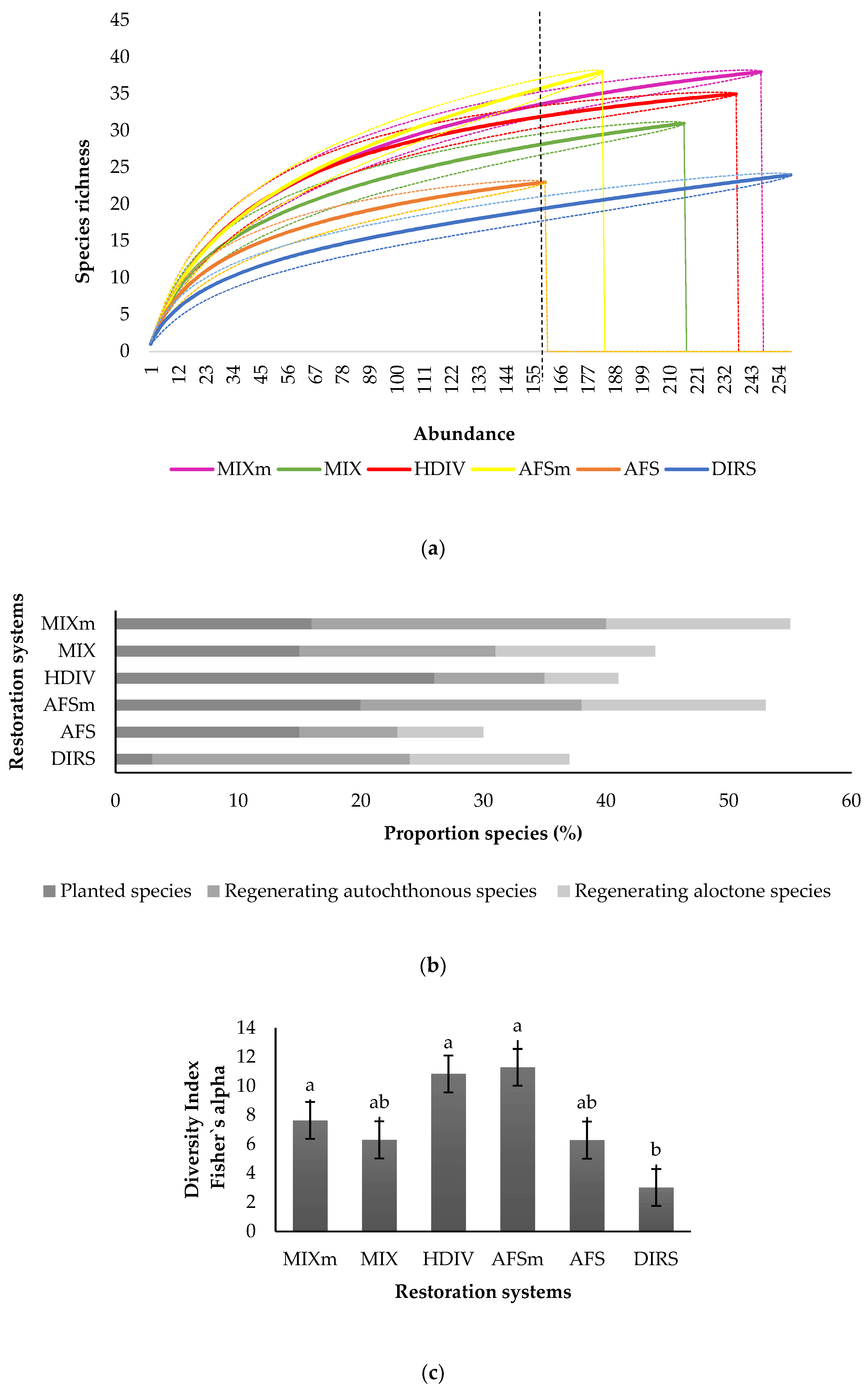
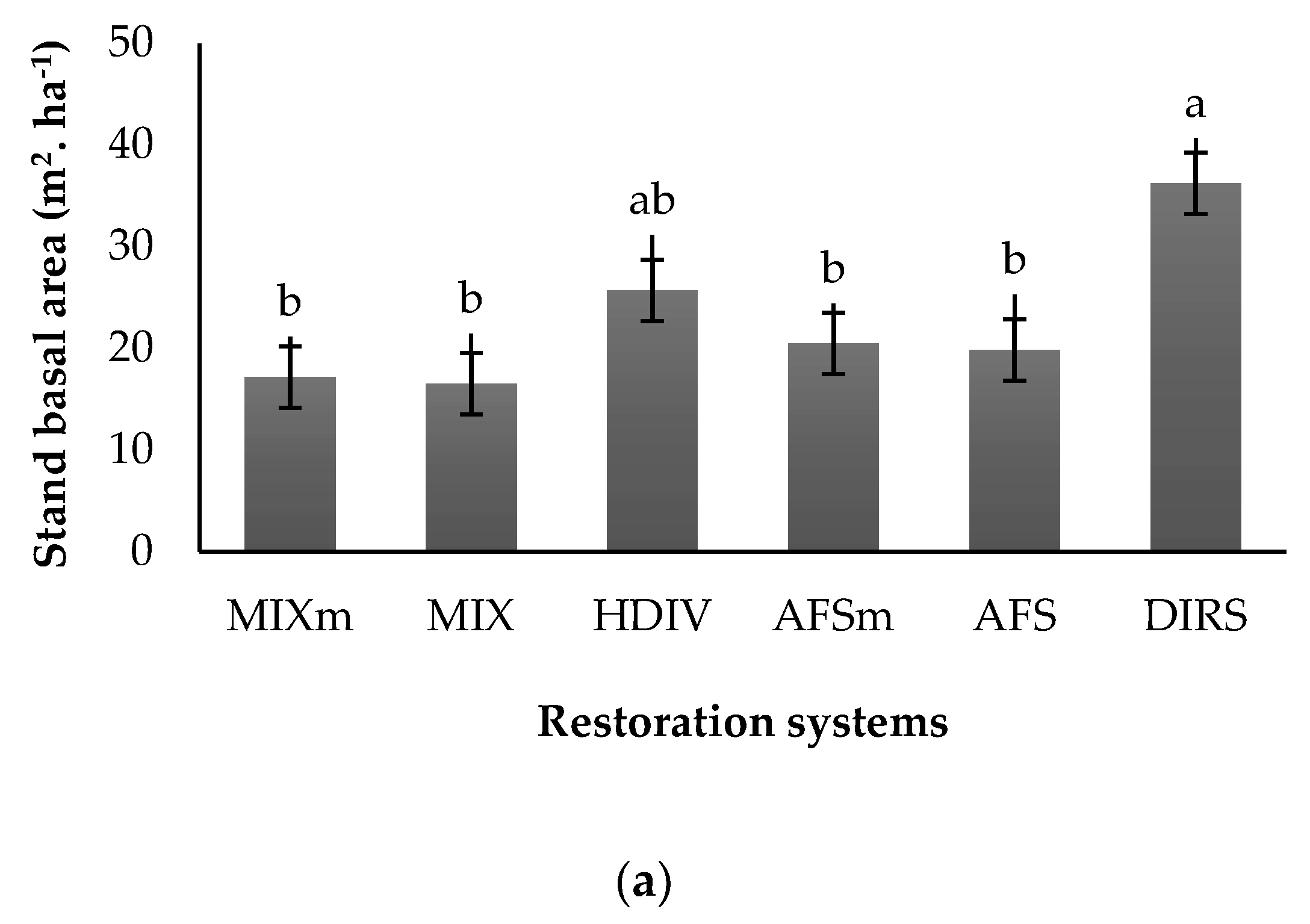
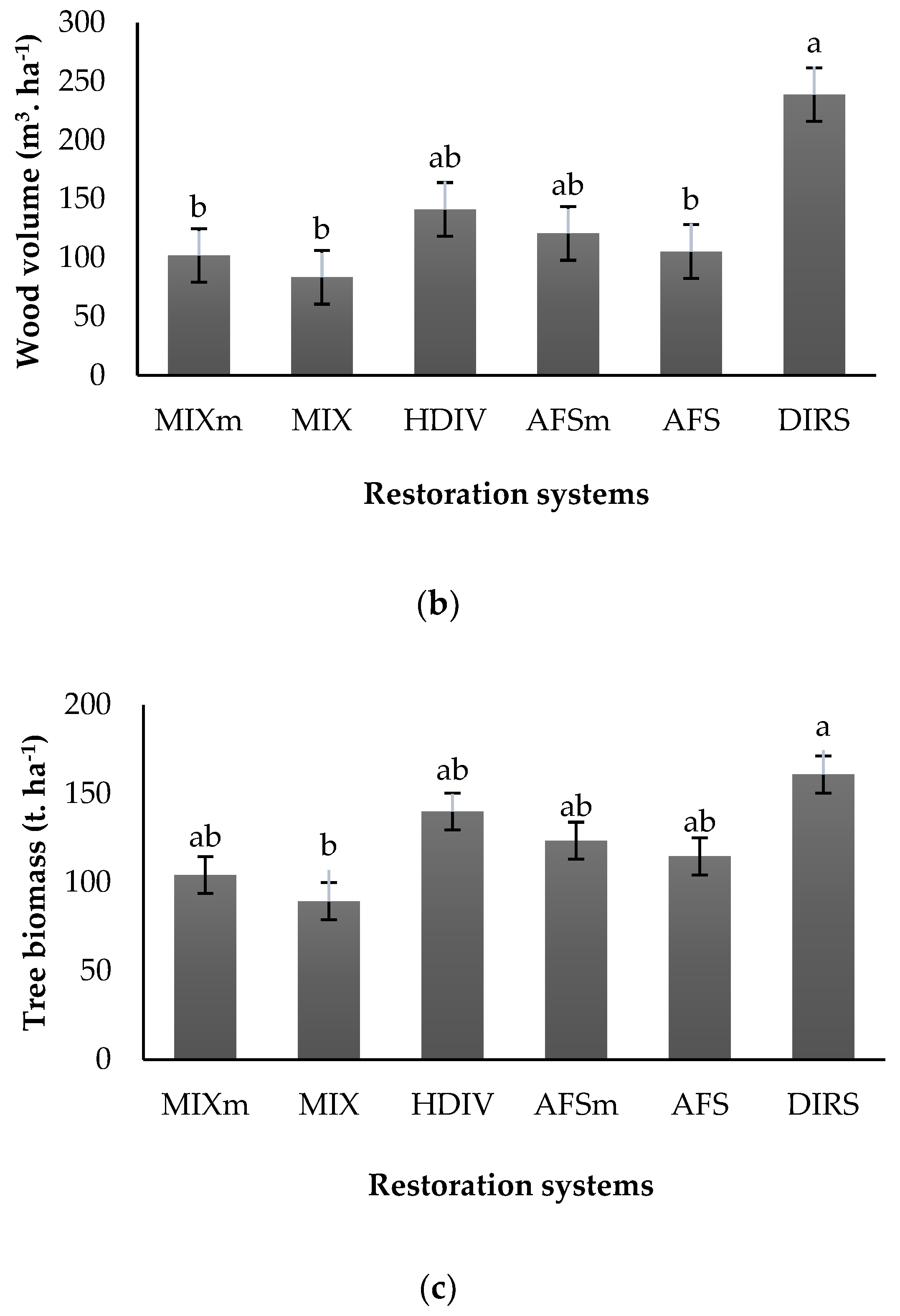
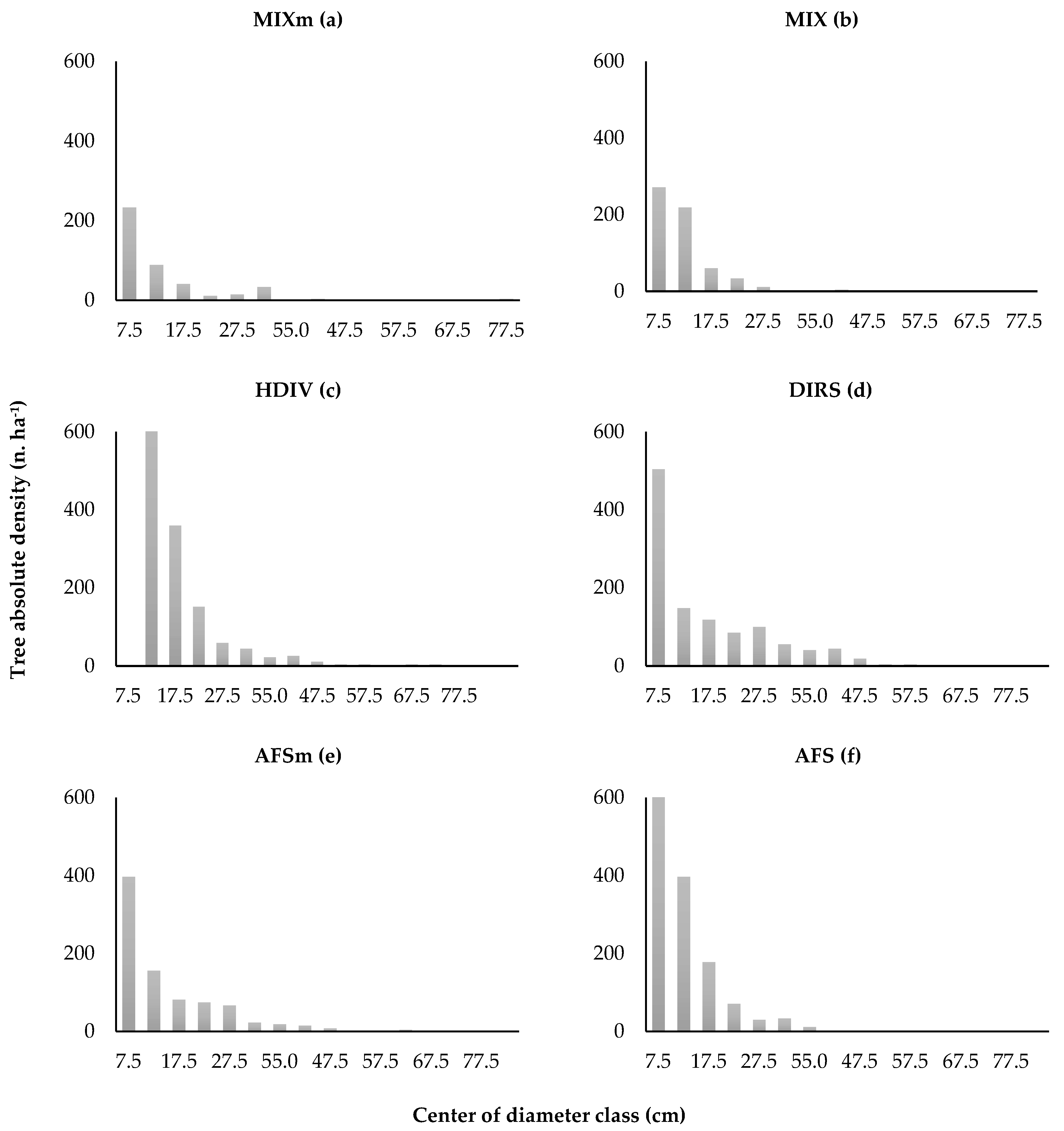
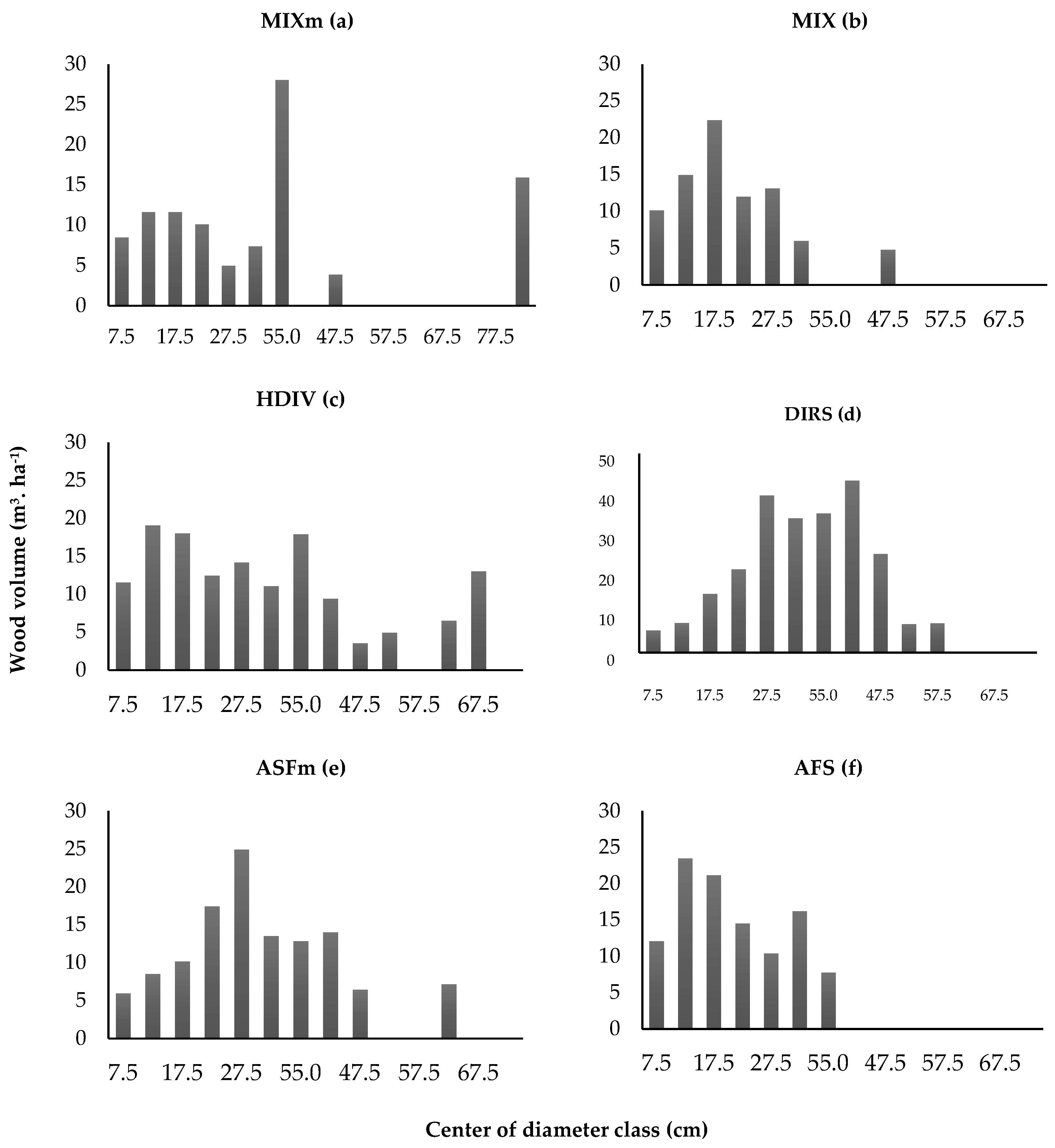
| Soil | pH | OMa | Presin | K | Ca | Mg | H + Al | Vb | N | CECc | Sand | Silt | Clay |
|---|---|---|---|---|---|---|---|---|---|---|---|---|---|
| CaCl2 | g·dm−3 | mg·dm−3 | cmolc·dm−3 | % | mmolc·dm−3 | g·kg−1 | |||||||
| Ultisol | 0–5 cm | 0–20 cm | |||||||||||
| 5.8 | 51 | 40 | 4.7 | 84 | 26 | 26.1 | 82 | 0.155 | 97.1 | ||||
| 5–10 cm | 0–10 cm | ||||||||||||
| 5.7 | 44 | 22 | 4.8 | 59 | 22 | 28.4 | 76 | 300 | 170 | 530 | |||
| 10–20 cm | 10–20 cm | ||||||||||||
| 5.7 | 37 | 16 | 3.6 | 77 | 18 | 32.5 | 77 | 210 | 120 | 670 | |||
| 20–40 cm | 20–40 cm | ||||||||||||
| 5.6 | 26 | 13 | 1.8 | 64 | 15 | 30.4 | 72 | 223 | 127 | 650 | |||
| Alfisol | 0–5 cm | 0–20 cm | |||||||||||
| 5.6 | 16 | 27 | 2.3 | 18 | 12 | 13.1 | 67 | 0.06 | 36.8 | ||||
| 5–10 cm | 0–10 cm | ||||||||||||
| 5.1 | 14 | 19 | 1.7 | 14 | 8.4 | 16.6 | 56 | 920 | 0 | 80 | |||
| 10–20 cm | 10–20 cm | ||||||||||||
| 4.6 | 11 | 12 | 1.3 | 12 | 5.8 | 19.6 | 47 | 899 | 0 | 101 | |||
| 20–40 cm | 20–40 cm | ||||||||||||
| 4.4 | 6.5 | 10 | 1.3 | 10 | 4.8 | 22.5 | 38 | 852 | 27 | 121 | |||
| Forest Structure Variables (means ± S.E.) | Forest Productivity Variables (means ± S.E.) | |||||
|---|---|---|---|---|---|---|
| Site | Total Height (m) | Tree Density (individuals·ha−1) | Stand Basal Area (m2·ha−1) | Diversity Index (α) | Wood Volume (m3·ha−1) | Tree Biomass (t·ha−1) |
| Ultisol (U) | 11.61 ± 4.61 a | 702 ± 148 b | 22.779 a | 8.67 ± 4.93 a | 142.31 ± 50.98 a | 130.87 ± 32.17 a |
| Alfisol (A) | 9.19 ± 4.10 b | 906 ± 393 a | 22.543 a | 6.86 ± 4.10 a | 121.61 ± 83.62 b | 113.28 ± 50.14 a |
| p-value | <0.0001 | 0.0182 | 0.9196 | 0.0579 | 0.0215 | 0.1631 |
| F-value | 34.97 | 6.3225 | 0.0104 | 3.9230 | 5.9531 | 2.0561 |
© 2019 by the authors. Licensee MDPI, Basel, Switzerland. This article is an open access article distributed under the terms and conditions of the Creative Commons Attribution (CC BY) license (http://creativecommons.org/licenses/by/4.0/).
Share and Cite
Pontes, D.M.F.; Engel, V.L.; Parrotta, J.A. Forest Structure, Wood Standing Stock, and Tree Biomass in Different Restoration Systems in the Brazilian Atlantic Forest. Forests 2019, 10, 588. https://doi.org/10.3390/f10070588
Pontes DMF, Engel VL, Parrotta JA. Forest Structure, Wood Standing Stock, and Tree Biomass in Different Restoration Systems in the Brazilian Atlantic Forest. Forests. 2019; 10(7):588. https://doi.org/10.3390/f10070588
Chicago/Turabian StylePontes, Danila Morena Fidéles, Vera Lex Engel, and John A. Parrotta. 2019. "Forest Structure, Wood Standing Stock, and Tree Biomass in Different Restoration Systems in the Brazilian Atlantic Forest" Forests 10, no. 7: 588. https://doi.org/10.3390/f10070588
APA StylePontes, D. M. F., Engel, V. L., & Parrotta, J. A. (2019). Forest Structure, Wood Standing Stock, and Tree Biomass in Different Restoration Systems in the Brazilian Atlantic Forest. Forests, 10(7), 588. https://doi.org/10.3390/f10070588





